Comprehensive Report on Systems Analysis and Design Principles
VerifiedAdded on 2023/06/18
|13
|2477
|142
Report
AI Summary
This report provides a comprehensive overview of systems analysis and design principles, focusing on the development of an information system for a book issue process. It begins with an introduction to systems analysis and design, highlighting its importance in improving business functionalities. The report includes a context diagram illustrating the interrelationship between external entities and the system, followed by a Level 0 Data Flow Diagram (DFD) that outlines the major high-level processes and their interrelations. Three key processes from the Level 0 DFD are then decomposed into Level 1 DFDs for a more detailed analysis. Furthermore, the report presents an Entity Relationship Diagram (ERD) to define the entities and relationships within the system's database. Finally, it identifies the data stores, including files not part of the ERD, and discusses the importance of data security, normalization, and backup in database management systems. The report concludes by emphasizing the significance of systems analysis and design in real-world organizations.
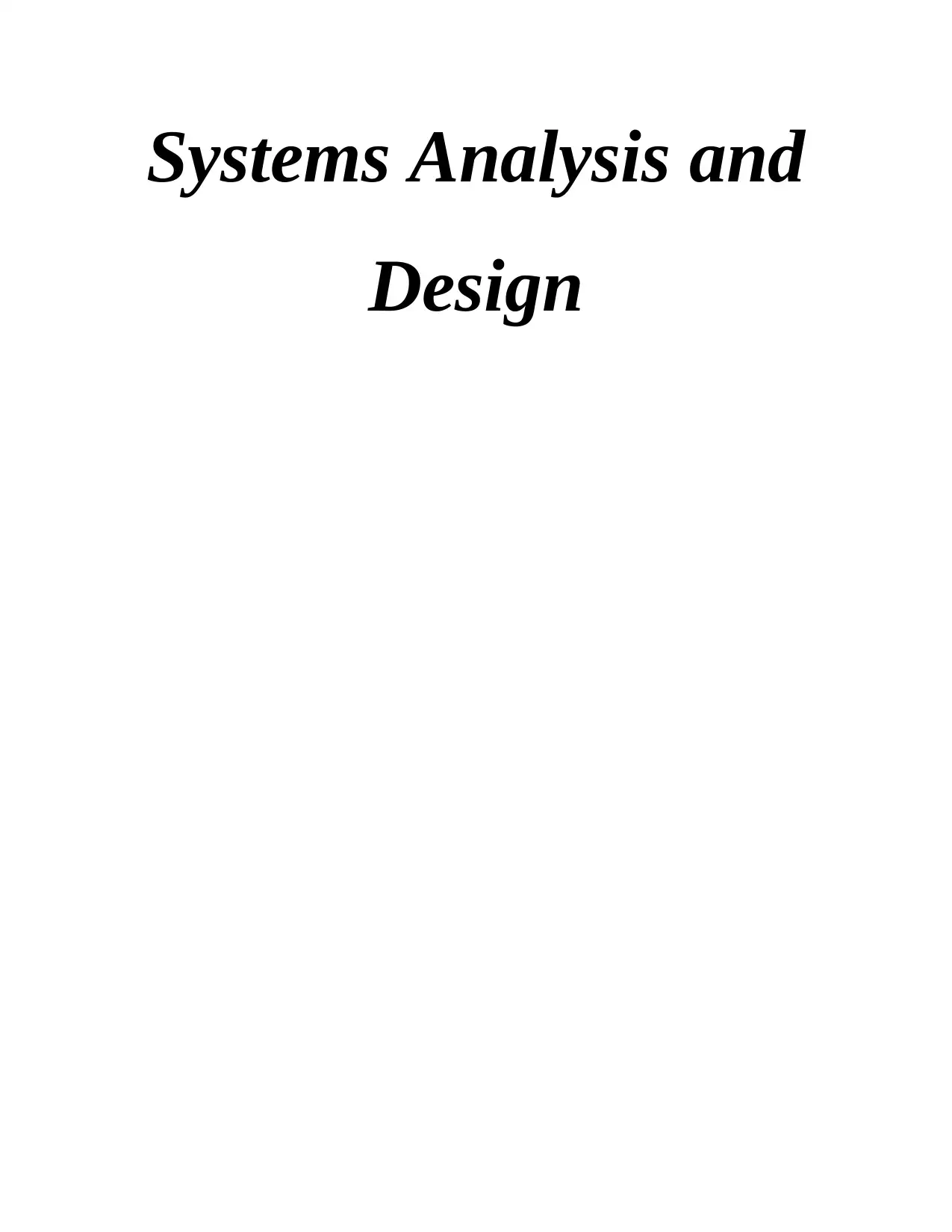
Systems Analysis and
Design
Design
Paraphrase This Document
Need a fresh take? Get an instant paraphrase of this document with our AI Paraphraser

Table of Contents
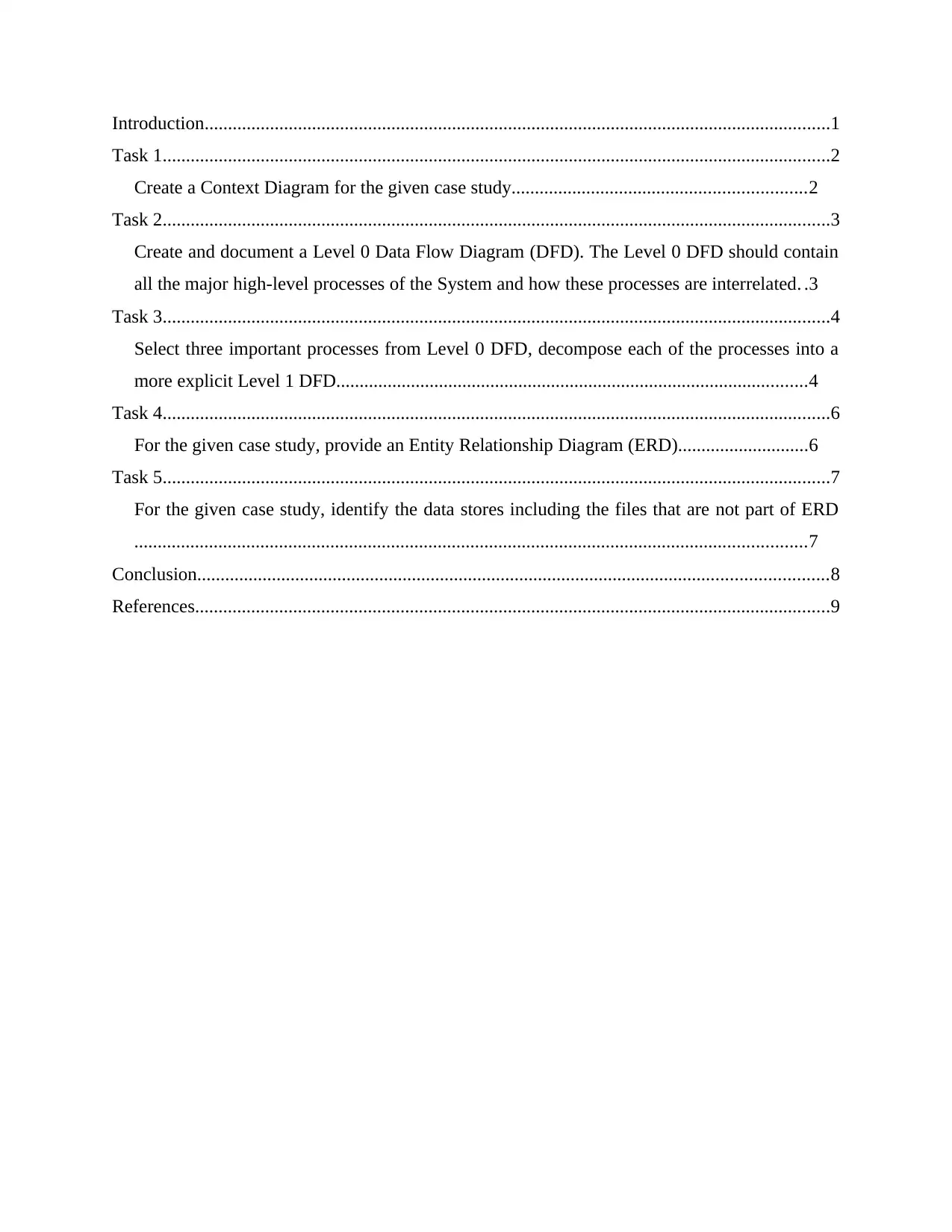
Introduction......................................................................................................................................1
Task 1...............................................................................................................................................2
Create a Context Diagram for the given case study...............................................................2
Task 2...............................................................................................................................................3
Create and document a Level 0 Data Flow Diagram (DFD). The Level 0 DFD should contain
all the major high-level processes of the System and how these processes are interrelated. .3
Task 3...............................................................................................................................................4
Select three important processes from Level 0 DFD, decompose each of the processes into a
more explicit Level 1 DFD.....................................................................................................4
Task 4...............................................................................................................................................6
For the given case study, provide an Entity Relationship Diagram (ERD)............................6
Task 5...............................................................................................................................................7
For the given case study, identify the data stores including the files that are not part of ERD
................................................................................................................................................7
Conclusion.......................................................................................................................................8
References........................................................................................................................................9
Task 1...............................................................................................................................................2
Create a Context Diagram for the given case study...............................................................2
Task 2...............................................................................................................................................3
Create and document a Level 0 Data Flow Diagram (DFD). The Level 0 DFD should contain
all the major high-level processes of the System and how these processes are interrelated. .3
Task 3...............................................................................................................................................4
Select three important processes from Level 0 DFD, decompose each of the processes into a
more explicit Level 1 DFD.....................................................................................................4
Task 4...............................................................................................................................................6
For the given case study, provide an Entity Relationship Diagram (ERD)............................6
Task 5...............................................................................................................................................7
For the given case study, identify the data stores including the files that are not part of ERD
................................................................................................................................................7
Conclusion.......................................................................................................................................8
References........................................................................................................................................9
⊘ This is a preview!⊘
Do you want full access?
Subscribe today to unlock all pages.

Trusted by 1+ million students worldwide

Paraphrase This Document
Need a fresh take? Get an instant paraphrase of this document with our AI Paraphraser
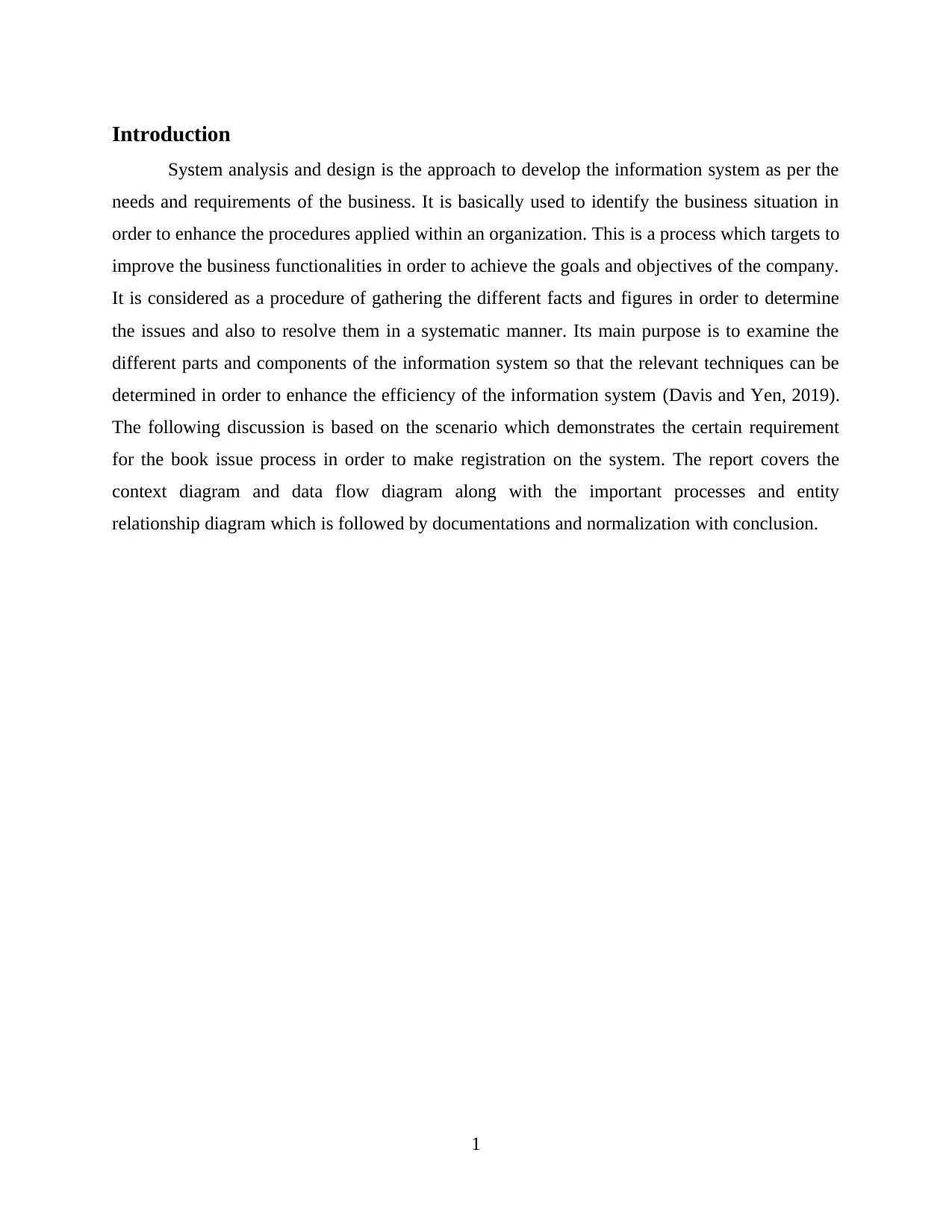
Introduction
System analysis and design is the approach to develop the information system as per the
needs and requirements of the business. It is basically used to identify the business situation in
order to enhance the procedures applied within an organization. This is a process which targets to
improve the business functionalities in order to achieve the goals and objectives of the company.
It is considered as a procedure of gathering the different facts and figures in order to determine
the issues and also to resolve them in a systematic manner. Its main purpose is to examine the
different parts and components of the information system so that the relevant techniques can be
determined in order to enhance the efficiency of the information system (Davis and Yen, 2019).
The following discussion is based on the scenario which demonstrates the certain requirement
for the book issue process in order to make registration on the system. The report covers the
context diagram and data flow diagram along with the important processes and entity
relationship diagram which is followed by documentations and normalization with conclusion.
1
System analysis and design is the approach to develop the information system as per the
needs and requirements of the business. It is basically used to identify the business situation in
order to enhance the procedures applied within an organization. This is a process which targets to
improve the business functionalities in order to achieve the goals and objectives of the company.
It is considered as a procedure of gathering the different facts and figures in order to determine
the issues and also to resolve them in a systematic manner. Its main purpose is to examine the
different parts and components of the information system so that the relevant techniques can be
determined in order to enhance the efficiency of the information system (Davis and Yen, 2019).
The following discussion is based on the scenario which demonstrates the certain requirement
for the book issue process in order to make registration on the system. The report covers the
context diagram and data flow diagram along with the important processes and entity
relationship diagram which is followed by documentations and normalization with conclusion.
1
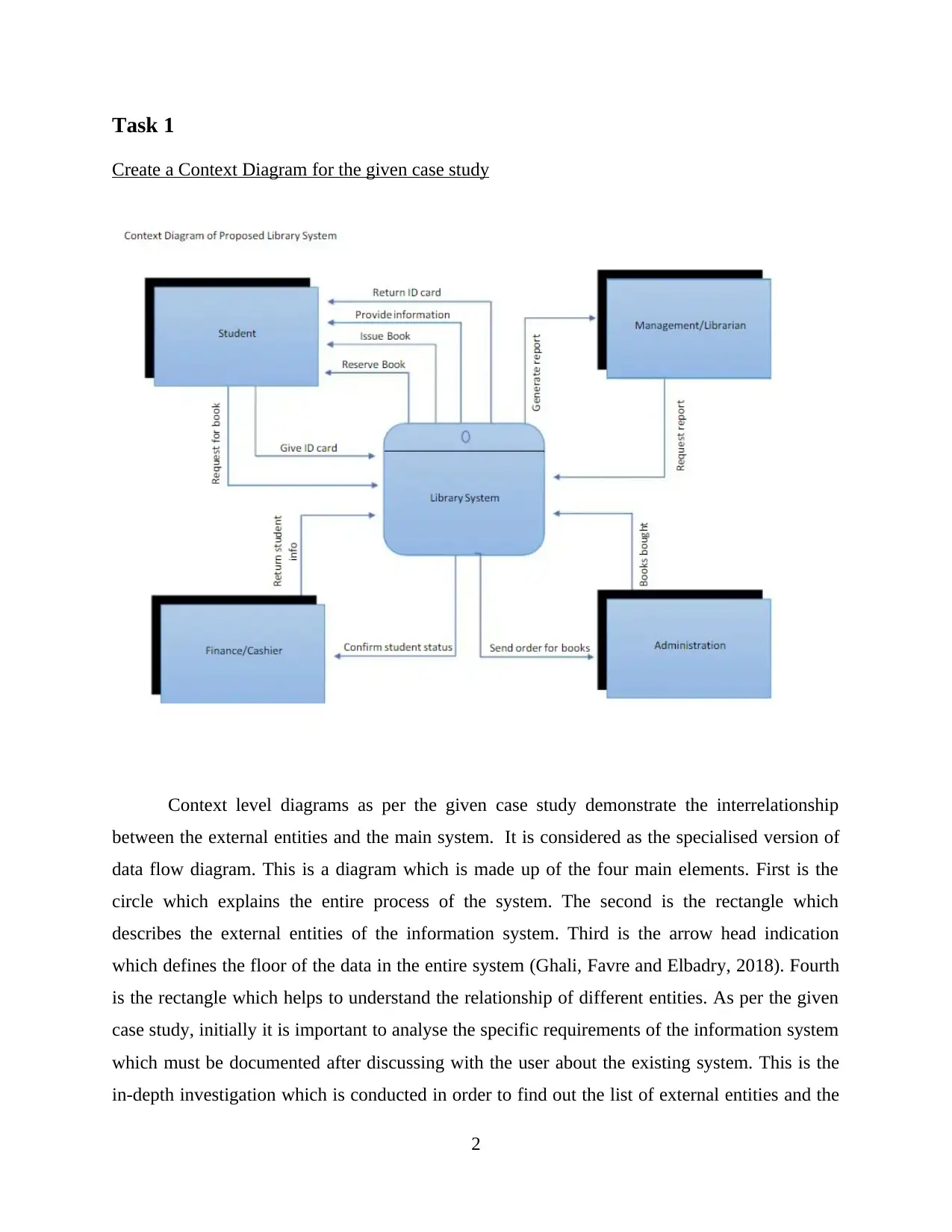
Task 1
Create a Context Diagram for the given case study
Context level diagrams as per the given case study demonstrate the interrelationship
between the external entities and the main system. It is considered as the specialised version of
data flow diagram. This is a diagram which is made up of the four main elements. First is the
circle which explains the entire process of the system. The second is the rectangle which
describes the external entities of the information system. Third is the arrow head indication
which defines the floor of the data in the entire system (Ghali, Favre and Elbadry, 2018). Fourth
is the rectangle which helps to understand the relationship of different entities. As per the given
case study, initially it is important to analyse the specific requirements of the information system
which must be documented after discussing with the user about the existing system. This is the
in-depth investigation which is conducted in order to find out the list of external entities and the
2
Create a Context Diagram for the given case study
Context level diagrams as per the given case study demonstrate the interrelationship
between the external entities and the main system. It is considered as the specialised version of
data flow diagram. This is a diagram which is made up of the four main elements. First is the
circle which explains the entire process of the system. The second is the rectangle which
describes the external entities of the information system. Third is the arrow head indication
which defines the floor of the data in the entire system (Ghali, Favre and Elbadry, 2018). Fourth
is the rectangle which helps to understand the relationship of different entities. As per the given
case study, initially it is important to analyse the specific requirements of the information system
which must be documented after discussing with the user about the existing system. This is the
in-depth investigation which is conducted in order to find out the list of external entities and the
2
⊘ This is a preview!⊘
Do you want full access?
Subscribe today to unlock all pages.

Trusted by 1+ million students worldwide

flow of data which is related to the information system. It generally contains the label order of
the procedure which represents the drawing of the entire system. There are also the external
entities which are drawn around the circle which are connected with the processes with the help
of arrows that demonstrate the flow of data and the different packets of information (Rajaraman,
2018).
Task 2
Create and document a Level 0 Data Flow Diagram (DFD). The Level 0 DFD should contain all
the major high-level processes of the System and how these processes are interrelated
A 0 level data flow diagram demonstrates the entire system and the way the
communication is being done between the external entities. A zero level data flow diagram is
used to visualise the implementation and the operation of the information system. This is because
it provides the analyser with the motive to input the data so that it can affect the entire system as
per the desired output. This is done to gain the desired output with its relevant nature. It contains
3
the procedure which represents the drawing of the entire system. There are also the external
entities which are drawn around the circle which are connected with the processes with the help
of arrows that demonstrate the flow of data and the different packets of information (Rajaraman,
2018).
Task 2
Create and document a Level 0 Data Flow Diagram (DFD). The Level 0 DFD should contain all
the major high-level processes of the System and how these processes are interrelated
A 0 level data flow diagram demonstrates the entire system and the way the
communication is being done between the external entities. A zero level data flow diagram is
used to visualise the implementation and the operation of the information system. This is because
it provides the analyser with the motive to input the data so that it can affect the entire system as
per the desired output. This is done to gain the desired output with its relevant nature. It contains
3
Paraphrase This Document
Need a fresh take? Get an instant paraphrase of this document with our AI Paraphraser

all the major procedures of the information system along with the interrelationship among them
(Kheir, 2018). The 0 level data flow diagram shows the systematic way of information which
enters and leaves the information system along with its storage of that particular information.
The motive of a data flow diagram is to demonstrate the boundaries and scope of the information
system as a whole. The diagram contains various processes such as management of the books
and the payment system along with the authentication view of data which is followed by the
enrolment and emails. It also involves the different entities such as the customer and its
enrolment officer along with the director of the booking system. It also involves the different
databases which contain the customer database and the books database along with the supplier
database and payment database. The rows which are used in the diagram basically represent the
messages which are passed on throughout the information system at the time of the processing of
the information (Gould, 2019).
Task 3
Select three important processes from Level 0 DFD, decompose each of the processes into a
more explicit Level 1 DFD
4
(Kheir, 2018). The 0 level data flow diagram shows the systematic way of information which
enters and leaves the information system along with its storage of that particular information.
The motive of a data flow diagram is to demonstrate the boundaries and scope of the information
system as a whole. The diagram contains various processes such as management of the books
and the payment system along with the authentication view of data which is followed by the
enrolment and emails. It also involves the different entities such as the customer and its
enrolment officer along with the director of the booking system. It also involves the different
databases which contain the customer database and the books database along with the supplier
database and payment database. The rows which are used in the diagram basically represent the
messages which are passed on throughout the information system at the time of the processing of
the information (Gould, 2019).
Task 3
Select three important processes from Level 0 DFD, decompose each of the processes into a
more explicit Level 1 DFD
4
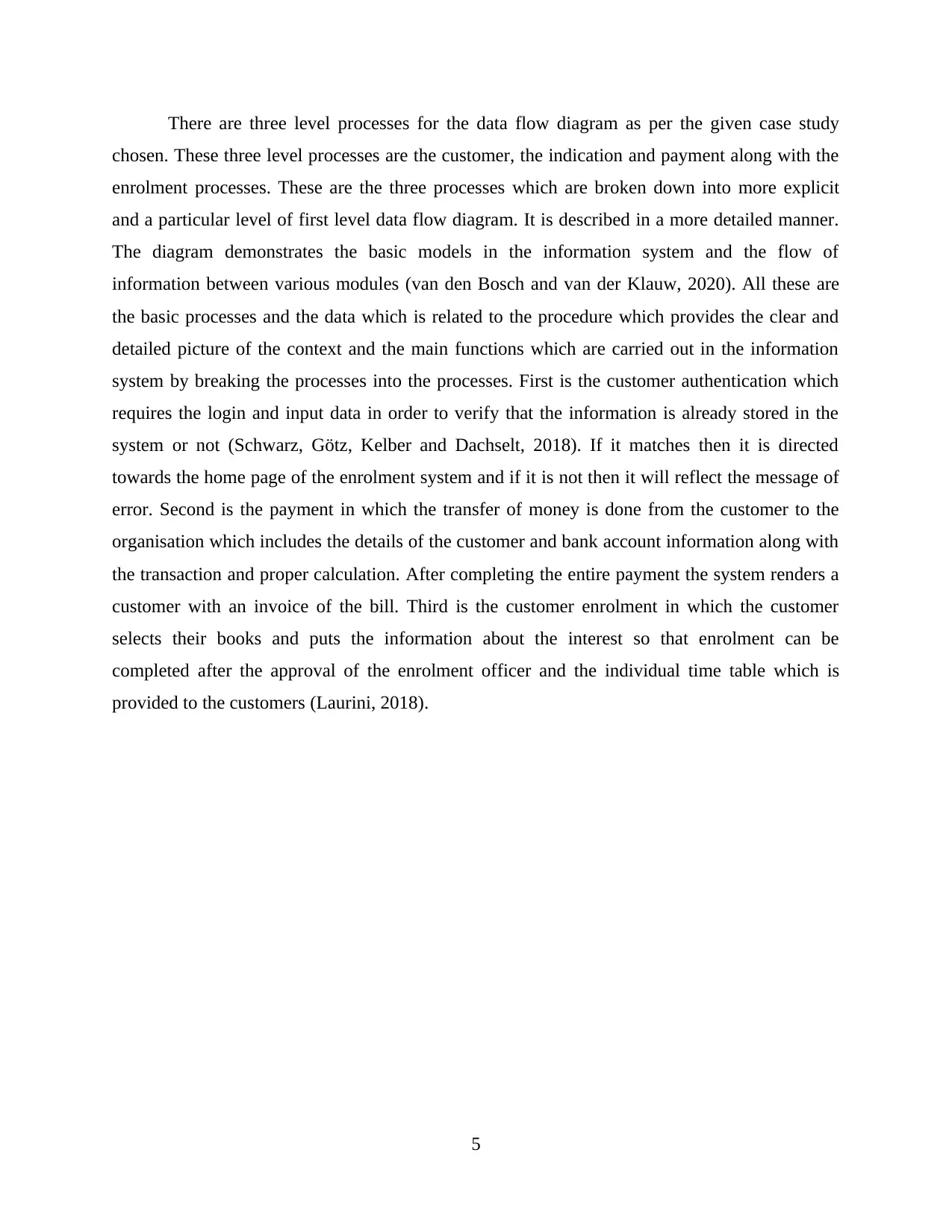
There are three level processes for the data flow diagram as per the given case study
chosen. These three level processes are the customer, the indication and payment along with the
enrolment processes. These are the three processes which are broken down into more explicit
and a particular level of first level data flow diagram. It is described in a more detailed manner.
The diagram demonstrates the basic models in the information system and the flow of
information between various modules (van den Bosch and van der Klauw, 2020). All these are
the basic processes and the data which is related to the procedure which provides the clear and
detailed picture of the context and the main functions which are carried out in the information
system by breaking the processes into the processes. First is the customer authentication which
requires the login and input data in order to verify that the information is already stored in the
system or not (Schwarz, Götz, Kelber and Dachselt, 2018). If it matches then it is directed
towards the home page of the enrolment system and if it is not then it will reflect the message of
error. Second is the payment in which the transfer of money is done from the customer to the
organisation which includes the details of the customer and bank account information along with
the transaction and proper calculation. After completing the entire payment the system renders a
customer with an invoice of the bill. Third is the customer enrolment in which the customer
selects their books and puts the information about the interest so that enrolment can be
completed after the approval of the enrolment officer and the individual time table which is
provided to the customers (Laurini, 2018).
5
chosen. These three level processes are the customer, the indication and payment along with the
enrolment processes. These are the three processes which are broken down into more explicit
and a particular level of first level data flow diagram. It is described in a more detailed manner.
The diagram demonstrates the basic models in the information system and the flow of
information between various modules (van den Bosch and van der Klauw, 2020). All these are
the basic processes and the data which is related to the procedure which provides the clear and
detailed picture of the context and the main functions which are carried out in the information
system by breaking the processes into the processes. First is the customer authentication which
requires the login and input data in order to verify that the information is already stored in the
system or not (Schwarz, Götz, Kelber and Dachselt, 2018). If it matches then it is directed
towards the home page of the enrolment system and if it is not then it will reflect the message of
error. Second is the payment in which the transfer of money is done from the customer to the
organisation which includes the details of the customer and bank account information along with
the transaction and proper calculation. After completing the entire payment the system renders a
customer with an invoice of the bill. Third is the customer enrolment in which the customer
selects their books and puts the information about the interest so that enrolment can be
completed after the approval of the enrolment officer and the individual time table which is
provided to the customers (Laurini, 2018).
5
⊘ This is a preview!⊘
Do you want full access?
Subscribe today to unlock all pages.

Trusted by 1+ million students worldwide
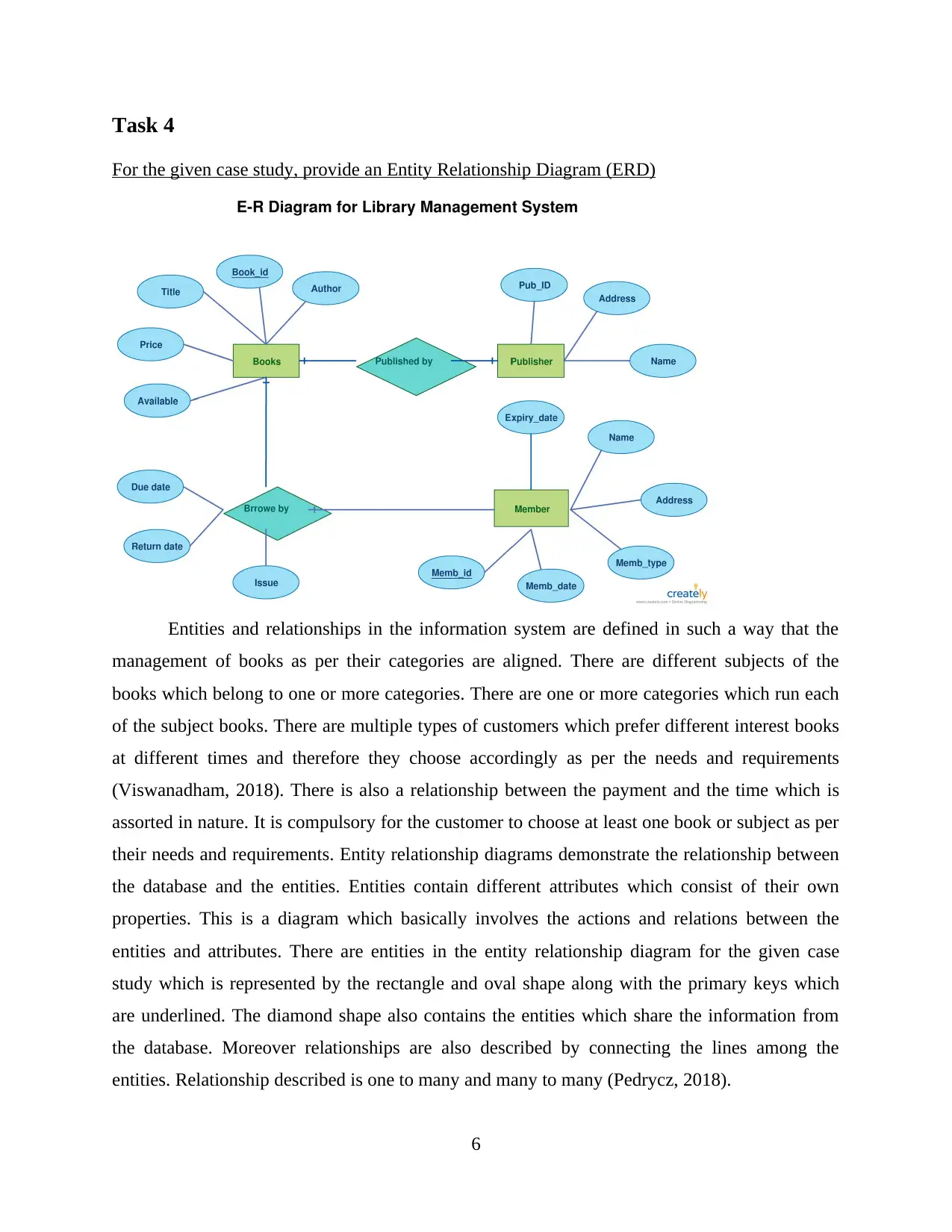
Task 4
For the given case study, provide an Entity Relationship Diagram (ERD)
Entities and relationships in the information system are defined in such a way that the
management of books as per their categories are aligned. There are different subjects of the
books which belong to one or more categories. There are one or more categories which run each
of the subject books. There are multiple types of customers which prefer different interest books
at different times and therefore they choose accordingly as per the needs and requirements
(Viswanadham, 2018). There is also a relationship between the payment and the time which is
assorted in nature. It is compulsory for the customer to choose at least one book or subject as per
their needs and requirements. Entity relationship diagrams demonstrate the relationship between
the database and the entities. Entities contain different attributes which consist of their own
properties. This is a diagram which basically involves the actions and relations between the
entities and attributes. There are entities in the entity relationship diagram for the given case
study which is represented by the rectangle and oval shape along with the primary keys which
are underlined. The diamond shape also contains the entities which share the information from
the database. Moreover relationships are also described by connecting the lines among the
entities. Relationship described is one to many and many to many (Pedrycz, 2018).
6
For the given case study, provide an Entity Relationship Diagram (ERD)
Entities and relationships in the information system are defined in such a way that the
management of books as per their categories are aligned. There are different subjects of the
books which belong to one or more categories. There are one or more categories which run each
of the subject books. There are multiple types of customers which prefer different interest books
at different times and therefore they choose accordingly as per the needs and requirements
(Viswanadham, 2018). There is also a relationship between the payment and the time which is
assorted in nature. It is compulsory for the customer to choose at least one book or subject as per
their needs and requirements. Entity relationship diagrams demonstrate the relationship between
the database and the entities. Entities contain different attributes which consist of their own
properties. This is a diagram which basically involves the actions and relations between the
entities and attributes. There are entities in the entity relationship diagram for the given case
study which is represented by the rectangle and oval shape along with the primary keys which
are underlined. The diamond shape also contains the entities which share the information from
the database. Moreover relationships are also described by connecting the lines among the
entities. Relationship described is one to many and many to many (Pedrycz, 2018).
6
Paraphrase This Document
Need a fresh take? Get an instant paraphrase of this document with our AI Paraphraser
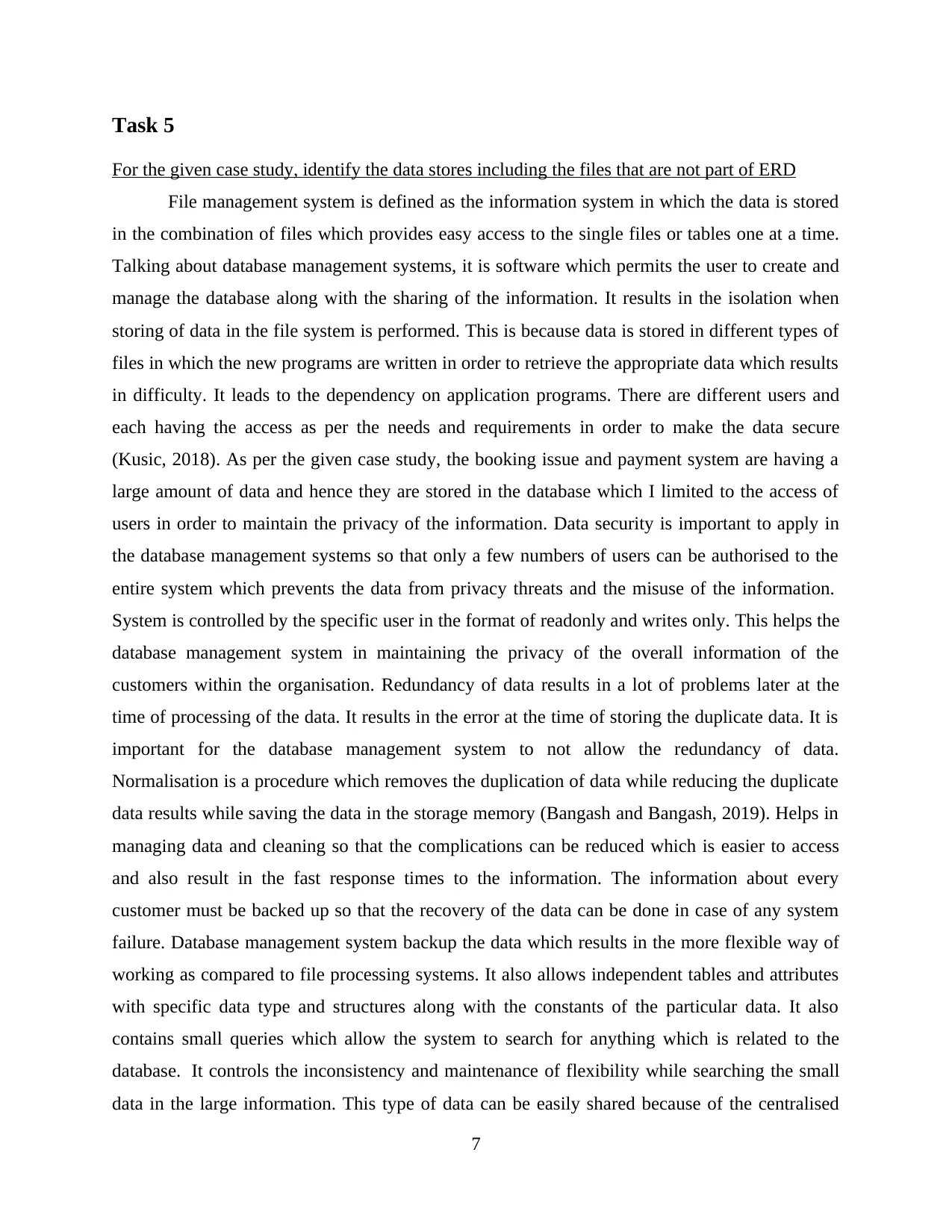
Task 5
For the given case study, identify the data stores including the files that are not part of ERD
File management system is defined as the information system in which the data is stored
in the combination of files which provides easy access to the single files or tables one at a time.
Talking about database management systems, it is software which permits the user to create and
manage the database along with the sharing of the information. It results in the isolation when
storing of data in the file system is performed. This is because data is stored in different types of
files in which the new programs are written in order to retrieve the appropriate data which results
in difficulty. It leads to the dependency on application programs. There are different users and
each having the access as per the needs and requirements in order to make the data secure
(Kusic, 2018). As per the given case study, the booking issue and payment system are having a
large amount of data and hence they are stored in the database which I limited to the access of
users in order to maintain the privacy of the information. Data security is important to apply in
the database management systems so that only a few numbers of users can be authorised to the
entire system which prevents the data from privacy threats and the misuse of the information.
System is controlled by the specific user in the format of readonly and writes only. This helps the
database management system in maintaining the privacy of the overall information of the
customers within the organisation. Redundancy of data results in a lot of problems later at the
time of processing of the data. It results in the error at the time of storing the duplicate data. It is
important for the database management system to not allow the redundancy of data.
Normalisation is a procedure which removes the duplication of data while reducing the duplicate
data results while saving the data in the storage memory (Bangash and Bangash, 2019). Helps in
managing data and cleaning so that the complications can be reduced which is easier to access
and also result in the fast response times to the information. The information about every
customer must be backed up so that the recovery of the data can be done in case of any system
failure. Database management system backup the data which results in the more flexible way of
working as compared to file processing systems. It also allows independent tables and attributes
with specific data type and structures along with the constants of the particular data. It also
contains small queries which allow the system to search for anything which is related to the
database. It controls the inconsistency and maintenance of flexibility while searching the small
data in the large information. This type of data can be easily shared because of the centralised
7
For the given case study, identify the data stores including the files that are not part of ERD
File management system is defined as the information system in which the data is stored
in the combination of files which provides easy access to the single files or tables one at a time.
Talking about database management systems, it is software which permits the user to create and
manage the database along with the sharing of the information. It results in the isolation when
storing of data in the file system is performed. This is because data is stored in different types of
files in which the new programs are written in order to retrieve the appropriate data which results
in difficulty. It leads to the dependency on application programs. There are different users and
each having the access as per the needs and requirements in order to make the data secure
(Kusic, 2018). As per the given case study, the booking issue and payment system are having a
large amount of data and hence they are stored in the database which I limited to the access of
users in order to maintain the privacy of the information. Data security is important to apply in
the database management systems so that only a few numbers of users can be authorised to the
entire system which prevents the data from privacy threats and the misuse of the information.
System is controlled by the specific user in the format of readonly and writes only. This helps the
database management system in maintaining the privacy of the overall information of the
customers within the organisation. Redundancy of data results in a lot of problems later at the
time of processing of the data. It results in the error at the time of storing the duplicate data. It is
important for the database management system to not allow the redundancy of data.
Normalisation is a procedure which removes the duplication of data while reducing the duplicate
data results while saving the data in the storage memory (Bangash and Bangash, 2019). Helps in
managing data and cleaning so that the complications can be reduced which is easier to access
and also result in the fast response times to the information. The information about every
customer must be backed up so that the recovery of the data can be done in case of any system
failure. Database management system backup the data which results in the more flexible way of
working as compared to file processing systems. It also allows independent tables and attributes
with specific data type and structures along with the constants of the particular data. It also
contains small queries which allow the system to search for anything which is related to the
database. It controls the inconsistency and maintenance of flexibility while searching the small
data in the large information. This type of data can be easily shared because of the centralised
7

system and also the concurrent access to the information. It means that multiple users have
authentication to access the same data at the same time (Martin, 2020).
Conclusion
It is concluded that system analysis and design is an important concept to learn and
schedule so that its applications can be applied in real world organizations. This is because it
provides the relevant structure in order to develop the information system as per the needs and
requirements of the business. This framework is essential to understand for better functioning of
the business. Therefore the above report has the information such as the context diagram and
data flow diagram along with the processes and entity relationship diagram. It is essential to
examine the documentations and normalization of all such concepts of system analysis and
design. Hence this report covers all such areas in order to better understand the conception of
system analysis and design in context of a particular case study.
8
authentication to access the same data at the same time (Martin, 2020).
Conclusion
It is concluded that system analysis and design is an important concept to learn and
schedule so that its applications can be applied in real world organizations. This is because it
provides the relevant structure in order to develop the information system as per the needs and
requirements of the business. This framework is essential to understand for better functioning of
the business. Therefore the above report has the information such as the context diagram and
data flow diagram along with the processes and entity relationship diagram. It is essential to
examine the documentations and normalization of all such concepts of system analysis and
design. Hence this report covers all such areas in order to better understand the conception of
system analysis and design in context of a particular case study.
8
⊘ This is a preview!⊘
Do you want full access?
Subscribe today to unlock all pages.

Trusted by 1+ million students worldwide
1 out of 13
Related Documents
Your All-in-One AI-Powered Toolkit for Academic Success.
+13062052269
info@desklib.com
Available 24*7 on WhatsApp / Email
![[object Object]](/_next/static/media/star-bottom.7253800d.svg)
Unlock your academic potential
Copyright © 2020–2025 A2Z Services. All Rights Reserved. Developed and managed by ZUCOL.





